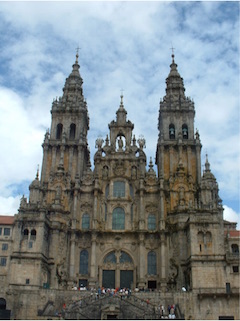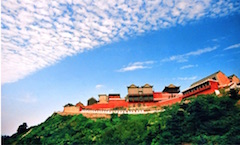| |
|
 |
Green Pilgrimage Network newsletter Number 11: November 2014
November 26 2014:
A message from Alison Hilliard, GPN DirectorI’ve been to two inspirational events recently.
One was attending the United Nation’s World Tourism Organisation’s first ever meeting on pilgrimage and tourism, held in the historic city of Santiago de Compostela in Spain. There we heard that one third of all tourists worldwide last year were pilgrims- that’s 330 million people!
As we gathered in St James’s Cathedral and watched the legendary incense burner, the botafumeiro, swing from the rooftop, it was time to reflect on the power and potential of pilgrimage to protect our shared planet and transform our world.
A few weeks later came the launch of the GPN Canterbury Partnership. Here, 40 groups from local businesses, hotels, tourism offices, city council and the Cathedral and Church of England Canterbury Diocese, came together to pledge their commitment to Canterbury becoming a green pilgrim city. This new model of GPN partnership was launched in the historic Eastbridge Hospital in Canterbury- a place that has provided hospitality to pilgrims since the 12th century. Its patron for the last 800 years has been the Church of England’s Archbishop of Canterbury and today’s Archbishop, the Most Rev Justin Welby, gave us his blessing - describing the GPN as “an encounter to celebrate and recognise that God is in every part of life”.
Read more about the two events in this newsletter – an edition where we also welcome four new members to the GPN- from Lithuania and China. We also have the launch of our new GPN handbook. Thank you for all the inspiring and varied action it records since the GPN was launched 3 years ago. I hope you enjoy!
Alison
 |
 |
 |
The Basilica at Santiago de Compostela, site of the UN WTO Congress on Tourism and Pilgrimage |
1st UN World Tourism Organisation congress on tourism and pilgrimageGreen issues were very much on the agenda when the first ever international meeting on tourism and pilgrimage was convened in Santiago de Compostela, Spain, from 17-20 September 2014. The meeting was called by the UN’s World Tourism Organisation and very suitably it was held in Santiago de Compostela in northern Spain, the traditional medieval pilgrimage destination for Europeans, with the astonishing claim that there are even more pilgrims today than there were in the Middle Ages.
Last year 215,000 pilgrims, of 115 different nationalities, arrived at Santiago de Compostela after having walked for 100km or more (many of them have travelled, relatively greenly, 800km or more from France, and some have walked or cycled from thousands of kilometres away). Santiago de Compostela is also a member of the Green Pilgrimage Network.
The meeting was attended by people from pilgrim places all around the world, including the Kumbh Mela (which every three years has to deal with tens of millions of people arriving from all over India for a Hindu festival), St Olav’s Way from Norway to Sweden, pilgrim places in Cyprus, the Vatican in Rome, Kumano Kodo in Japan, California Mission with the Franciscans, the Loyola Ignatian Way, the Andean Route in Argentina, Lalibela and Negash Mosque in Ethiopia, the Basilica Ruta Santa del Peregrino in Guaremala, the new Holy Family pilgrimage route being created in Egypt, the Jeju Olle sacred trail in Korea, Abraham’s Path, Medjugorje in Bosnia and Herzegovina, the Shaolin Temple and Zhengzhou in China and several others.
Each one of them testified to how pilgrimage is not an old fashioned thing, but seems to answer a question that people of all ages are asking today. All of them are seeing numbers increase. Official UN figures are now that there are 330 million tourists making a spiritual pilgrimage each year.
A key theme in the meeting became the power and potential of spiritual tourism or pilgrimage to make a positive difference in our world. And climate change and environmental care constantly came up from the speakers. There were sessions on the sustainability of pilgrimage tourism and on nature as inspiration for tourism and pilgrimage.
People also testified how, although it can leave terrible rubbish and mess, and be a challenge on resources and local wildlife, pilgrimage at its best can make people want to be more kind to the earth, and can also promote the local community with local sustainable crafts, jobs, food, and accommodation. It’s a way of bringing in tourism and promoting the local economy and jobs
“Pilgrimage is the true tourism,” Alberto Nunez Feijoo, president of the regional government of Galicia, told us. “It’s an opportunity to feel someone is by our side, sharing the same values, the same ideas of freedom... When you travel you become a better person…”
There are plans to set up an international centre to welcome pilgrims to Santiago de Compostela. And after the meeting it looks likely that that centre will be planned, from the beginning, to be sustainable and to promote sustainability because it’s part of what everyone believes.
Canterbury points the way forwardThe steering committee of the European Chapter of the Green Pilgrimage Network met in Canterbury on 10 and 11 November to discuss the future of the Green Pilgrimage Network. More on this in the next newsletter...
A special evening was organised to hear from the author Harry Bucknall. His new book ‘ Like a Tramp, Like a Pilgrim’, describes his experiences of the 2,200 km walk along the Via Francigena from Canterbury to Rome, including the stories of fellow pilgrims he met on the way. For him “pilgrimage is the most special undertaking you can ever do” giving an opportunity “ to restore the factory settings on our computer and a chance to reconnect with life at the pace it’s meant to be lived at.”
Harry Bucknall’s talk on pilgrimage was organised by the newly launched GPN Canterbury Partnership.
This enterprising partnership is a new initiative by the Diocese of Canterbury and draws together some 40 local sacred sites, pilgrim routes, food producers and tourism authorities in a commitment to making pilgrimage through the region environmentally friendly.
The Partnership was launched on October 3, 2014 and was followed by a weekend of pilgrimage events in a city that has been a pilgrimage centre since the 7th century.
You can read more about the Green Pilgrimage Network Canterbury Partnership on the Diocesan website here and a newspaper report on Harry Bucknall’s Via Francigena pilgrimage here including the GPN Canterbury Partnership’s five top tips on pilgrimage.
GPN handbook updated
One of the great things about being in a network of people confronting similar issues and problems is that you can learn from each other’s experiences – whether good or bad.
That’s why we’ve just updated our Green Pilgrimage Handbook to reflect the many examples of good practice and inspirational problem solving that GPN members have told us about since the original version was written for the network launch at Assisi in 2011.
Welcome new partners!When the first 12 members launched the Green Pilgrimage Network in 2011 everyone looked forward to other sacred sites coming forward to help the network grow and spread a green message to pilgrims around the world. By the time we had our meeting in Trondheim, Norway in July 2013 another 16 sites were ready to join the GPN, representing India, Europe, the Middle East and Central America, more than doubling the membership up to 28.
 |
 |
 |
Palace of the Nine Heavens, Maoshan Mountain |
In May 2014, three Daoist pilgrim cities joined the network – Ziyang, Maoshan and Houzhenzi. These three Chinese cities have already taken a number of environmentally protective measures: as well as housing sacred shrines both Ziyang and Houzhenzi are the sites of important water reservoirs so have banned all polluting industries, while Maoshan has converted to solar powered street lamps and has banned the use of private cars in the site.
Our latest new member is the pilgrim city of Vilnius in Lithuania. Welcome! Vilnius is home to many pilgrimage destinations including, most notably, the Gates of Dawn chapel with its famous silver-encrusted painting of the Virgin Mary. The Lithuanian government is planning to create a special pilgrim route recreating the journey of Pope John Paul II’s 1997 visit to the city and its shrines.
Daoism leads the way to a greener ChinaJust as Ziyang, Maoshan and Houzhenzi join founder member Louguan to give the GPN four Daoist members in China, the Third International Daoist Forum will be making the environment one of its four main themes. Martin Palmer has been invited to attend the two day event in Longhu Shan, China later this month where the topic will be ‘The Axis of all Things: Ecological Wisdom in the Daoist Religion.’
Over the last few years the Chinese authorities have begun to look to Daoism to help address the environmental problems faced by the country, with substantial investments already helping create a model of sustainability in Louguan.
The amazing story of Daoism’s return from an officially reviled tradition to a socially valued influence was described by Dutch environmentalist and businessman Allerd Sticker, a long-time friend and partner of ARC, in his recent book ‘Sacred Mountains: how the revival of Daoism is turning China’s ecological crisis around’ (BFP, London, 2014). The book charts Allerd’s personal observation of the process as a supporter working with Martin Palmer and ARC to help restore Daoist monasteries as centres of environmental protection.
You can read more about ‘Sacred Mountains’ here.
Next edition and new additions!Next time – news of developments in the European Chapter of the Green Pilgrimage Network, pilgrimage news from Scotland and a new pilgrim tartan and news of the Pilgrimage to Paris for the next major UN climate change conference, COP21, in Paris 2015.
And a warm welcome to our climate pilgrim, Jean Leston, who joins GPN staff from WWF, and congratulations to GPN’s Chantal Elkin on the birth of a wonderful baby boy, Rafael, and to Ravneet Pal Singh on the birth of a wonderful baby girl, Man Hazuri Kaur…
Gentle journeys on your pilgrim path!...
Other linksDownload this GPN Newsletter as a PDF document
|
 |
 |
|
|
|
|
|

